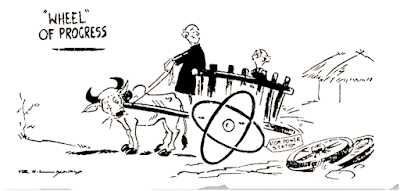1. C. Subhash Mukhopadhyay
(Pankaj Kapoor in "Ek Doctor Ki Maut")
"Ek Doctor Ki Maut" is a 1990
award-winning Hindi film starring Pankaj Kapur, Shabana Azmi, Anil Chatterjee
and Irfan Khan in lead roles by noted Bengali director Tapan Sinha, which
depicts the ostracism, bureaucratic negligence, reprimand and insult of a
doctor and his research, instead of recognition. The film is based on the story
"Abhimanyu" by Ramapada Chowdhury and is loosely based on the life of
Dr. Subhash Mukhopadhyay, an Indian Physician who pioneered the In vitro
fertilisation treatment just around the same time when another leading
scientist Dr. Robert Edwards was conducting separate experiments in England.
Subhash Mukhopadhyay (16 January 1931 –
19 June 1981) was an Indian Bengali scientist, physician from Hazaribagh, Jharkhand,
who created the world's second and India's first child (Durga) using in-vitro fertilization.
Kanupriya Agarwal (Durga), who was born in 1978, just 67 days after the first
IVF baby in United Kingdom. Afterwards, Dr. Subhash Mukhopadhyay was harassed
by the then West Bengal State government and Indian Government and not allowed
to share his achievements with the international scientific community.
Dejected, he committed suicide on 19 June 1981.
2. C. Wipro
Wipro (formerly, Western India Palm
Refined Oil Limited) is an Indian multinational corporation that provides
information technology, consulting and business process services. It is
headquartered in Bangalore, Karnataka, India.
(Azim Hashim Premji, Chairman of Wipro Limited)
The company was incorporated on 29
December 1945 in Amalner, Maharashtra by Mohamed Premji as "Western India
Palm Refined Oil Limited", later abbreviated to "Wipro". It was
initially set up as a manufacturer of vegetable and refined oils in Amalner,
Maharashtra. In 1966, after Mohamed Premji's death, his son Azim Premji took
over Wipro as its chairman at the age of 21. During the 1970s and 1980s, the
company shifted its focus to new opportunities in the IT and computing
industry, which was at a nascent stage in India at the time. On 7 June 1977,
the name of the company changed from Western India Vegetable Products Limited
to Wipro Products Limited. In 1982, the name was changed again, from Wipro
Products Limited to Wipro Limited.
In 2013, Wipro separated its non-IT
businesses and formed the privately owned Wipro Enterprises.
3. B. Chidambaram Subramaniam
Chidambaram Subramaniam (30 January
1910 – 7 November 2000), was an Indian politician and Independence activist who
served as Minister of Finance and Minister of Defence in the union cabinet. He
later served as the Governor of Maharashtra. As the Minister for Food and
Agriculture, he ushered the Indian Green Revolution, an era of self-sufficiency
in food production along with M. S. Swaminathan, B. Sivaraman and Norman E.
Borlaug. He was awarded Bharat Ratna, Indian's highest civilian award, in 1998,
for his role in ushering Green Revolution.
(American agronomist, ‘Father of the
Green Revolution’ and Nobel laureate, Dr Norman Borlaug (left) advising a
farmer on wheat development programmes during his visit to Bombay in 1971.
Borlaug regularly visited India during the rabi season, checking on wheat
development programmes.)
Along with M. S. Swaminathan and B.
Sivaraman, Subramaniam was the architect of India's modern agricultural
development policy, after the success of his programme which led to a record
production of wheat in 1972 termed as the Indian Green Revolution. As Minister
for Food and Agriculture, he introduced high-yielding varieties of seeds and
more intensive application of fertilizers which paved the way for increased
output of cereals and attainment of self-sufficiency in food-grains in the
country.
4. B. Indian Institute of Technology,
Kharagpur
The Indian Institute of Technology
Kharagpur is a public technical and research university established by the Government of India in 1951. It is the first of the IITs to be established and
is recognized as an "Institute of National Importance". In 2019, it
was awarded the status of "Institute of Eminence".
(Main Building of IIT, Kharagpur)
The institute was initially established
to train scientists and engineers after India attained independence in 1947 as
result of recommendation by a Committee led by Sir Jogendra Singh. On the grounds
that West Bengal had the highest concentration of industries at the time,
Bidhan Chandra Roy, the Chief Minister of West Bengal, persuaded Jawaharlal
Nehru (India's first prime minister) to establish the institute in West Bengal.
The first Indian Institute of Technology was thus established in May 1950 as
the "Eastern Higher Technical Institute". It was located in Esplanade
East, Calcutta, and in September 1950 shifted to its permanent campus at Hijli,
Kharagpur 120 kilometres south-west of Kolkata. Hijli had been used as a
detention camp during the British colonial rule in India, to keep Indian
freedom fighters captive.
The name "Indian Institute of
Technology" was adopted before the formal inauguration of the institute on
18 August 1951 by Maulana Abul Kalam Azad.
5. B. Super Computers
Vijay Pandurang Bhatkar is an Indian
computer scientist, IT leader and educationalist. He is best known as the
architect of India's national initiative in supercomputing where he led the
development of Param supercomputers in early 1990s. PARAM is a series of
supercomputers designed and assembled by the Centre for Development of Advanced
Computing (C-DAC) in Pune, India.
Bhatkar is a Padma Bhushan, Padma Shri
and Maharashtra Bhushan awardee. Bhatkar has been chancellor of Nalanda University,
India since January 2017 for a period of 3 years.













































